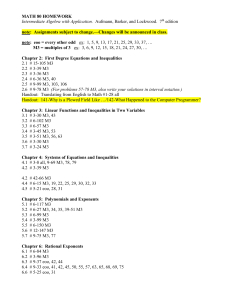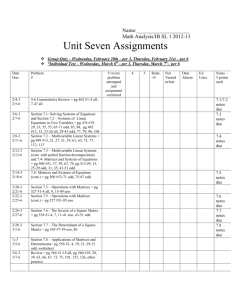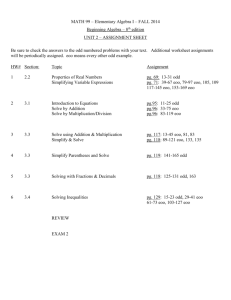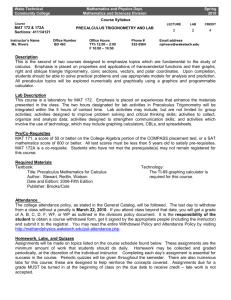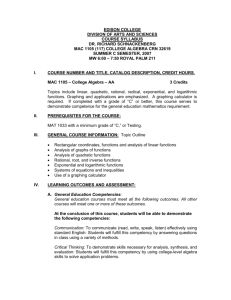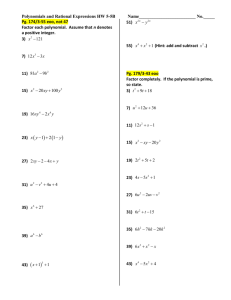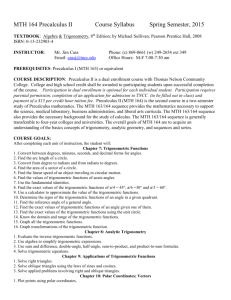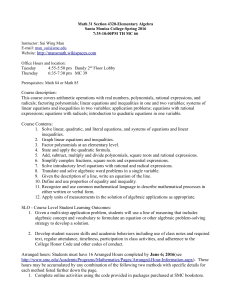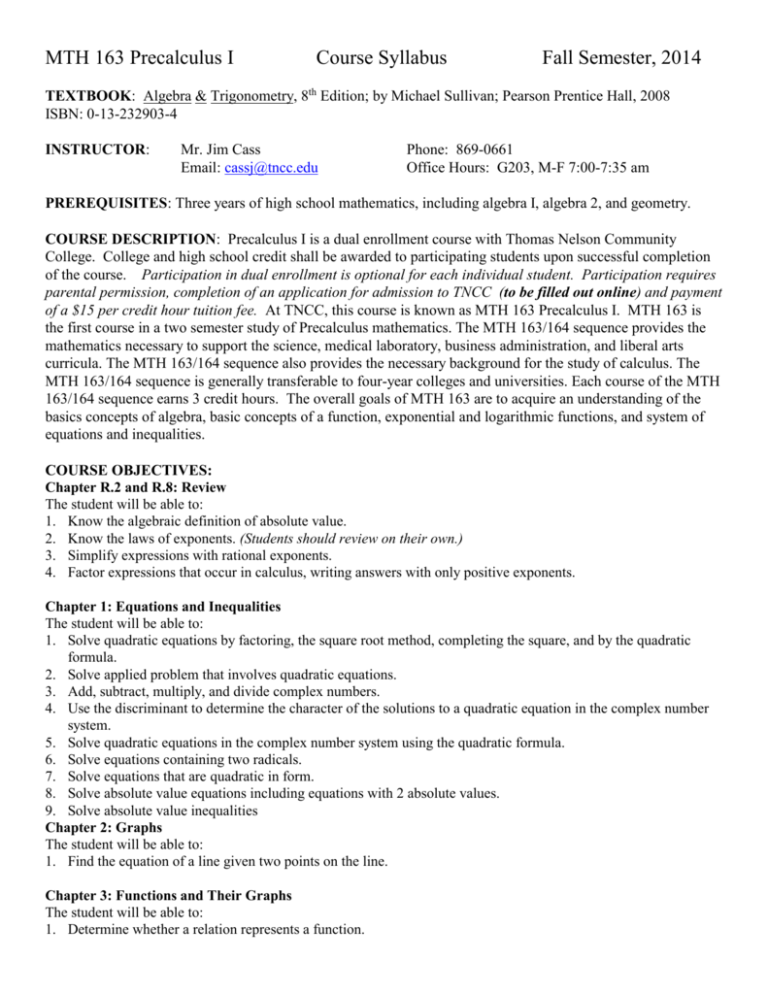
MTH 163 Precalculus I
Course Syllabus
Fall Semester, 2014
TEXTBOOK: Algebra & Trigonometry, 8th Edition; by Michael Sullivan; Pearson Prentice Hall, 2008
ISBN: 0-13-232903-4
INSTRUCTOR:
Mr. Jim Cass
Email: cassj@tncc.edu
Phone: 869-0661
Office Hours: G203, M-F 7:00-7:35 am
PREREQUISITES: Three years of high school mathematics, including algebra I, algebra 2, and geometry.
COURSE DESCRIPTION: Precalculus I is a dual enrollment course with Thomas Nelson Community
College. College and high school credit shall be awarded to participating students upon successful completion
of the course. Participation in dual enrollment is optional for each individual student. Participation requires
parental permission, completion of an application for admission to TNCC (to be filled out online) and payment
of a $15 per credit hour tuition fee. At TNCC, this course is known as MTH 163 Precalculus I. MTH 163 is
the first course in a two semester study of Precalculus mathematics. The MTH 163/164 sequence provides the
mathematics necessary to support the science, medical laboratory, business administration, and liberal arts
curricula. The MTH 163/164 sequence also provides the necessary background for the study of calculus. The
MTH 163/164 sequence is generally transferable to four-year colleges and universities. Each course of the MTH
163/164 sequence earns 3 credit hours. The overall goals of MTH 163 are to acquire an understanding of the
basics concepts of algebra, basic concepts of a function, exponential and logarithmic functions, and system of
equations and inequalities.
COURSE OBJECTIVES:
Chapter R.2 and R.8: Review
The student will be able to:
1. Know the algebraic definition of absolute value.
2. Know the laws of exponents. (Students should review on their own.)
3. Simplify expressions with rational exponents.
4. Factor expressions that occur in calculus, writing answers with only positive exponents.
Chapter 1: Equations and Inequalities
The student will be able to:
1. Solve quadratic equations by factoring, the square root method, completing the square, and by the quadratic
formula.
2. Solve applied problem that involves quadratic equations.
3. Add, subtract, multiply, and divide complex numbers.
4. Use the discriminant to determine the character of the solutions to a quadratic equation in the complex number
system.
5. Solve quadratic equations in the complex number system using the quadratic formula.
6. Solve equations containing two radicals.
7. Solve equations that are quadratic in form.
8. Solve absolute value equations including equations with 2 absolute values.
9. Solve absolute value inequalities
Chapter 2: Graphs
The student will be able to:
1. Find the equation of a line given two points on the line.
Chapter 3: Functions and Their Graphs
The student will be able to:
1. Determine whether a relation represents a function.
2. Evaluate a function.
3. Evaluate a difference quotient.
4. Find the domain of a function.
5.
Given the functions f and g, find ,and the domain of each operation (briefly). ,,fgfgfg+−⋅fg
6. Determine if a graph represents a function, and if so, give domain and range.
7. Obtain information from or about the graph of a function.
8. Given the graph of a function f, determine: the domain and range, whether f is even-odd-neither, intervals where
f is increasing-decreasing-constant, local maxima and local minima.
9. Identify even and odd functions from equations.
10. Use a graphing calculator to graph a function and determine local maxima and minima.
11. Find the average rate of change of a function.
12. Graph the functions in the library of functions given in the text.
13. Graph piecewise functions and state their domains.
14. Given the graph of a piecewise defined function, write a definition for the function.
15. Graph functions using horizontal and vertical shifts, compressions and stretches, reflection about the x-axis or yaxis, and using a combination of transformations.
16. Build a function to model a real world application.
Chapter 5: Polynomial and Rational Inequalities
The student will be able to:
1. Find the domain of a rational function.
2. Find the vertical asymptotes of a rational function.
3. Find horizontal or oblique asymptotes of a rational function.
4. Analyze the graph of a rational function. (Optional)
5. Solve polynomial and rational inequalities.
Chapter 6: Exponential and Logarithmic Functions
The student will be able to:
1. Evaluate a composite function.
2. Determine a composite function and find its domain.
3. Find the components of a composite function.
4. Given the graph of f, graph the inverse function f –1.
5. Given a function, find its inverse.
6. Determine if a function is 1-1.
7. Verify that two functions are inverses of each other.
8. Evaluate exponential functions.
9. Know domain and range of an exponential function.
10. *Graph an exponential function by plotting points.
11. Solve an exponential equation.
12. *Change an exponential expression to a logarithmic expression and vice versa.
13. *Evaluate logarithmic functions without a calculator.
14. *Determine the domain of a logarithmic function.
15. *Graph a logarithmic function by plotting points. Ex: 3ylogx=
*Note: Items indicated with an * must be done without a calculator
1.
2.
3.
4.
5.
6.
Solve logarithmic equations.
Use the properties of logarithms to find the exact value of an expression.
Write a logarithmic expression as a sum or difference of logarithms and vice versa.
Use the Change-of-Base formula and a calculator to evaluate a logarithm.
Solve exponential and logarithmic equation using the properties of logarithms.
Solve problem involving exponential growth and exponential decay.
Chapter 12: System of Equations and Inequalities
The student will be able to:
1. Solve a system of two or three linear equations using Cramer’s Rule.
2. Solve a system of two non-linear equations.
3. Find the partial fraction decomposition of a rational expression.
4. Solve a system of two linear equations using Matrices (optional).
COURSE MEETING TIMES: Monday through Friday, 1st period.
HOMEWORK: Homework problems for each section are assigned below. Following the classroom
presentation of the topic, the student is expected to study the assigned material and to work the assigned
problems before coming to the next class. Some class time will be spent discussing the difficulties encountered
with the homework exercises. Although homework is not normally collected and graded, you will not be
successful in this course without doing the homework.
TESTING: Eight tests are scheduled as well as a mandatory, comprehensive final exam. The eight tests will be
divided between the two quarters. Quizzes will be given periodically as well. Quizzes will normally cover two
sections. All tests and quizzes will be announced with ample opportunity for preparation.
GRADING POLICY: Grades are determined on a point system. Tests are worth 100 points, quizzes are
normally 20 points, pop quizzes are 5 or 10 points. Extra credit is available by attendance at Jefferson Lab
Science Series Lectures or the Air & Space Museum Sigma Series lectures. Each lecture is worth 10 points and
students are limited to 10 points per quarter per class. The following grade average scale will be used to
determine your final grade.
Average
Grade
93 – 100 %
A
85 – 92 %
B
76 – 84 %
C
70 – 75 %
D
Below 70 %
F
HOMEWORK ASSIGNMENTS
Section
R.4
R.5
R.6
R.7
R.8
1.1
1.2
1.3
1.4
1.5
1.6
1.7
2.1
2.2
2.3
2.4
2.5
Homework
1 – 85 EOO*
5 – 105 EOO
5 – 25 odd
5 – 81 EOO
5 – 69 EOO, 87, 91
17 – 89 EOO
9 – 85 EOO, 97, 101
9 – 77 EOO
9 – 85 EOO
25 – 97 EOO, 105, 117
9 – 53 EOO, 61, 65, 73
21 – 41 odd
17 – 45 EOO
5 – 73 EOO
13 – 97 EOO
13 – 49 EOO
5 – 23 odd
*EOO means every other odd
Section
3.1
3.2
3.3
3.4
3.5
5.2
5.4
6.1
6.2
6.3
6.4
6.5
6.6
6.7
6.8
12.1
Homework
17 – 77 EOO
9 – 27 odd
13 – 65 EOO
9 – 45 EOO
9 – 77 EOO
11 – 51 odd
5 – 39 odd
7 – 59 EOO
9 – 65 EOO
13 – 73 EOO
9 – 99 EOO
9 – 75 EOO
5 – 73 EOO
3 – 25 odd
1 -11 odd
17 – 53 EOO
ATTENDANCE REQUIREMENTS:
Regular school attendance is essential for a student’s academic success. When an absence
occurs, a parent / guardian should contact the school office that day to report and provide a
reason for the absence. Following an absence, it is important for a student to complete make-up
work to compensate for missed class time and to maintain a satisfactory grade. Missing class
due to participation in a school-sponsored activity does not count as an absence, but assignments
must be completed on time.
A student must be in school 4 hours (Middle School / High School: attend 4 classes) to be
marked present for the day. Student athletes marked absent for the day are not eligible to
participate in practice or games that day, unless approved by the Principal or Administrator.
Students must complete assignments in classes missed due to late arrival or early dismissal, or
grades will be reduced.
Any student who attains 10 absences in a semester will be placed under review by the Principal.
Absences in excess of 10 per semester may result in failing grades, loss of course credit, and may
jeopardize promotion to the next grade. The school administration will make the final decision
whether a student will pass or fail after contacting parent / guardians and reviewing the
circumstances of the absences.
Seniors with more than 5 absences in a class, excused or unexcused, will not be exempt from the
semester exam in that class. Approved college visits, and missing class due to participation in a
school-sponsored activity will not affect exam exemption.
LATE WORK/MAKE-UP/MISSED TEST POLICY: If a student misses a test or quiz due to an excused
absence, then the student is expected to make up the quiz or test as soon as possible upon return to school.
Makeup quizzes and tests will normally be done outside of class time, preferably in the morning before school
starts.
LAST DAY TO WITHDRAW WITH A “W” GRADE: December 5, 2014
INSTRUCTIONAL METHODS: The course content will be taught primarily through a series of lectures with
ample class time being reserved for student questions and interaction. Classroom participation is a vital part of
the instructional process. Students are encouraged to ask questions in class and demonstrate their ability to
solve problems.
ALTERNATE SOURCES OF INSTRUCTION (available at TNCC to dual enrollment students):
Instructional Videos: Khan Academy, www.khanacademy.org
The College Math Center: Library in Wythe Hall. The math center is available for students who need additional
help outside of class.
Tutorial Learning Center: Wythe Hall Room 253. The tutorial center is available to assist currently enrolled
students desiring additional help in their classes by providing them with peer tutors (when available).
STUDENTS WITH DISABILITIES.
DBCS believes every child deserves a quality education, regardless of physical, mental, or
emotional disabilities. However, facility, Faculty, and financial constraints make it impossible
for DBCS to accommodate children with disabilities at this time. Since we are unable to create a
proper learning environment, it would be a disservice to allow admission to children with
disabilities. Furthermore, if a current DBCS student is tested and diagnosed with a specific kind
of disability the school cannot accommodate, then the student will be released from the school.
The final decision on any admission shall be exclusively reserved to the School Management
Team. The Team’s decision is not subject to review or appeal.
CALCULATORS: A graphing calculator is an essential tool for this course and each student is expected to
have one. The TI-84 PLUS calculator is recommended because that is the model that will be used for
demonstrations in class.
STATEMENT ON PLAGIARISM/ACADEMIC HONESTY:
Scholastic dishonesty of any form will not be tolerated. Actions for scholastic dishonesty may include grade
reduction, failing grade for course, and/or recommendation for possible dismissal from the college.
POLICY ON CONTAGIOUS DISEASES.
Parents / guardians are asked to keep all students with fevers and contagious illnesses home.
This is a health consideration for the well-being of all our students, Faculty, and Staff. After the
illness, students need a signed note from parent / guardian stating the reason for missing school.
School policy is that a student must stay home with the following conditions:
ut vomiting before returning to school)
Students do, at times, come down with illnesses while at school. If that happens, the student will
be sent to the school clinic for evaluation by the school’s EMT to determine if the student should
stay in school or be sent home. If a student needs to be sent home, every effort will be made to
contact a parent / guardian. If a parent / guardian is not available, an emergency contact person
will be notified. Sick students will remain in the clinic until someone comes to pick them up.

